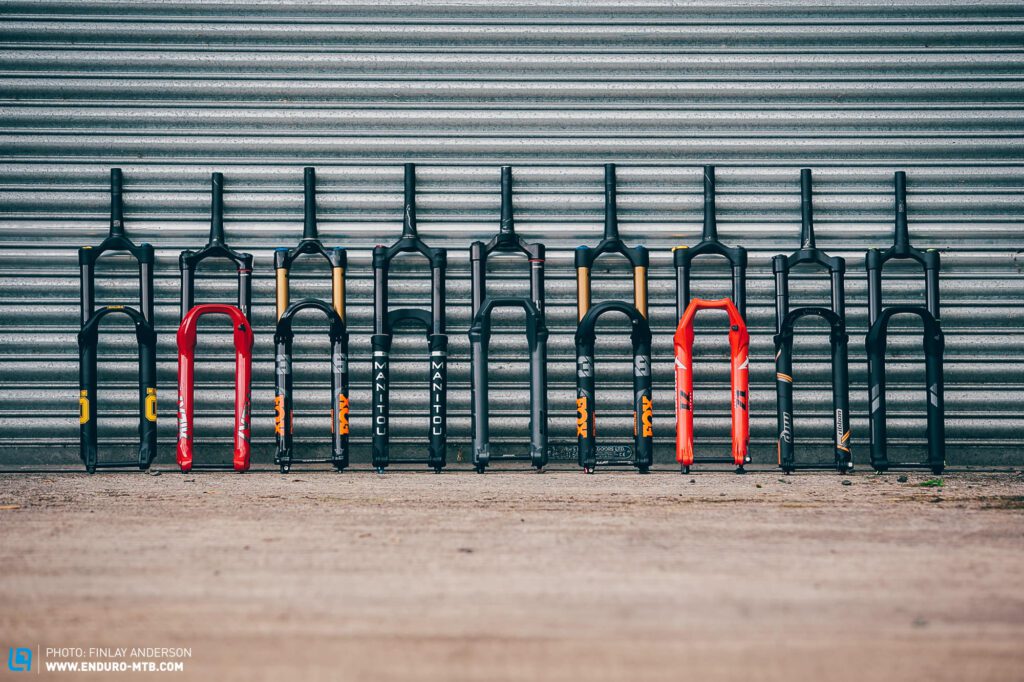The best mountain bike suspension is the one that provides optimal control and comfort while riding rough terrains. The suspension system absorbs shocks and impacts, allowing riders to maintain stability and maneuverability on challenging trails.
It is crucial to choose a suspension setup that matches your style of riding, terrain type, and personal preferences. Various types of suspension systems are available, such as hardtail and full-suspension bikes. Hardtails offer simplicity and efficient power transfer, while full-suspension bikes provide enhanced comfort and traction.
Regardless of the type, a well-tuned and quality suspension system is crucial for maximizing your mountain biking experience.
Choosing The Right Suspension
Choosing the right suspension is crucial when it comes to finding the best mountain bike for your riding style. With various suspension types available, it’s important to understand how each type works and what it can offer you.

Credit: www.mbr.co.uk
Key Factors To Consider
Choosing the best mountain bike suspension involves considering critical factors that impact your ride. From travel to wheel size compatibility, these elements play a significant role in performance.
Travel And Suspension Travel
- Travel: Determines how much the suspension compresses and absorbs impacts.
- Suspension Travel: Range of motion a suspension fork or shock provides.
Wheel Size And Compatibility
- Wheel Size: Standard options include 26″, 27.5″, and 29″ wheels.
- Compatibility: Ensure the suspension matches your wheel size for optimal performance.
Comparison Of Suspension Systems
Discovering the best mountain bike suspension can be a daunting task. Comparing different suspension systems can help in making an informed decision. Factors such as terrain, rider preferences, and budget play a crucial role in determining the most suitable suspension for an exhilarating mountain biking experience.
Air Suspension
Air suspension systems use compressed air as the primary means of providing the necessary shock absorption and damping on a mountain bike. This type of suspension is highly versatile and widely popular among riders due to its lightweight construction and adjustability. The air chambers in these systems can be easily manipulated to achieve different levels of stiffness, allowing riders to fine-tune their suspension according to their preferences and the trail conditions.
Coil Suspension
Coil suspension, on the other hand, relies on a metal coil spring to absorb the impacts and provide a smooth ride. This type of suspension is known for its ability to handle rough terrains and provide a consistent performance throughout the ride. With fewer moving parts, coil suspension systems are often considered more durable and reliable than air suspensions. Additionally, these systems are generally less expensive to maintain and repair compared to their air counterparts. However, they tend to be heavier than air suspensions, which can be a downside for riders looking for a lightweight setup.
Comparison Table
To better understand the differences between air and coil suspension systems, let’s compare them side by side:
| Air Suspension | Coil Suspension | |
|---|---|---|
| Adjustability | Highly adjustable, can be fine-tuned to personal preferences and trail conditions | Less adjustable, limited to spring rate changes |
| Weight | Lightweight construction | Heavier due to metal coil spring |
| Durability | Generally less durable than coil suspensions due to more complex design | Considered to be more durable and reliable |
| Maintenance | Requires regular maintenance and potential air leakage with extended use | Less frequent maintenance required |
In summary, air suspension systems offer lightweight construction and high adjustability, making them suitable for riders who want to customize their suspension for different terrains and preferences. On the other hand, coil suspension systems are known for their durability and ability to handle rough terrains, ideal for riders who prioritize reliability and consistent performance. Ultimately, the choice between air and coil suspension comes down to personal preference, riding style, and intended use of the mountain bike.
Setting Up Your Suspension
Adjusting Sag And Rebound
Adjusting sag and rebound is crucial for optimal performance. Start by setting sag to around 25-30% of your total travel. For rebound, slowly adjust until your bike rebounds smoothly without bouncing back too quickly.
Fine-tuning Compression Settings
Fine-tune compression settings based on your riding style. Increase compression for more support on rough terrain. Decrease compression for a plusher ride on smoother trails.
Maintenance And Upkeep
For the best mountain bike suspension, regular maintenance and upkeep are essential. Proper care of your suspension system can ensure optimal performance and longevity, providing a smooth and comfortable ride on various terrains. Consistent cleaning, lubrication, and inspection of components will help maintain the suspension’s functionality and enhance your biking experience.
Maintenance and Upkeep Mountain bike suspension systems are key components for a smooth and enjoyable ride, but they require regular maintenance to ensure optimal performance and longevity. Regular Cleaning and Lubrication It’s crucial to regularly clean and lubricate your mountain bike suspension to prevent dirt and grime from causing premature wear and affecting the performance of the system. Pay special attention to the stanchions and seals, using a mild detergent and soft brush to gently remove any accumulated dirt. Once clean, apply a specialized suspension lubricant to the stanchions to ensure smooth operation.
Understanding Wear and Tear As with any mechanical components, mountain bike suspension systems are subject to wear and tear over time. It’s important to keep an eye out for any signs of wear, such as excessive play or leaking oil, and address these issues promptly. Regular inspection and maintenance can help identify and address potential problems before they escalate, ultimately extending the lifespan of your suspension components. Regular cleaning and lubrication are essential for maintaining the performance and longevity of your mountain bike suspension. Understanding wear and tear and addressing issues promptly will ensure that your suspension system continues to provide smooth and reliable performance for many rides to come.
Enhancing Suspension Performance
Enhancing Suspension Performance is crucial for improving the overall ride quality and handling of your mountain bike. By upgrading components and adding damping adjustments, you can significantly enhance the effectiveness of your bike’s suspension system.
Upgrading Components
Upgrading key suspension components such as the fork and rear shock can noticeably improve the performance of your mountain bike’s suspension. Look for high-quality components that are specifically designed to enhance the overall suspension response and riding experience. Consider factors such as weight, durability, and performance when selecting new suspension components.
- Upgrade to a high-quality air or coil fork with adjustable travel to match your riding style and terrain.
- Invest in reliable and efficient rear shock absorbers with features such as dual air chambers or remote lockout for improved control.
- Consider lightweight and durable materials such as carbon fiber or titanium for enhanced performance.
Adding Damping Adjustments
Introducing damping adjustments to your mountain bike’s suspension system allows you to fine-tune the response and behavior of the suspension under varying riding conditions. Damping adjustments enable riders to customize their suspension setup for optimal performance and comfort.
- Install a high-quality aftermarket damping unit along with your suspension fork or rear shock to gain access to a wider range of adjustment options.
- Experiment with compression and rebound settings to achieve the desired level of control and stability while riding over different terrains.
- Consider investing in electronic or hydraulic damping systems for precise and instantaneous adjustments on the trail.
Special Considerations For Enduro And Downhill Riding
When choosing the best mountain bike suspension for enduro and downhill riding, it is crucial to consider the terrain’s demands. Opt for a suspension system that offers a balance of responsiveness and control to handle varying trail conditions effectively. Adjustability and durability are key factors to look for in a mountain bike suspension.
Balancing Control And Impact Absorption
When it comes to enduro and downhill riding, finding the best mountain bike suspension becomes crucial in order to strike the right balance between control and impact absorption.
Enduro and downhill riding are all about pushing the limits and tackling challenging terrains at high speeds. This requires a suspension system that can withstand the intense forces and provide the necessary control to navigate through rough sections.
One of the key considerations for riders in these disciplines is the balance between control and impact absorption. Too soft of a suspension can result in excessive body movement and instability, while a suspension that is too firm can lead to a harsh ride and reduced traction. Achieving the perfect balance is essential for maintaining control and maximizing overall performance.
Optimizing Performance For Technical Terrain
When it comes to enduro and downhill riding, technical terrain poses a unique set of challenges that riders must be prepared for. The suspension system plays a crucial role in optimizing performance and enhancing the rider’s ability to tackle technical sections with confidence and precision.
A key factor to consider when choosing the best mountain bike suspension for technical terrain is the adjustability of the system. With adjustable compression and rebound settings, riders can fine-tune their suspension to best suit the specific challenges of the trail, whether it’s steep descents, tight corners, or big jumps.
Additionally, the suspension should offer enough travel to handle the demanding nature of technical terrain. Longer travel provides additional cushioning, helping to absorb impacts and maintain traction on uneven surfaces. However, it’s important to find the right balance of travel to avoid excessive weight and pedal bob, which can impact overall efficiency.

Credit: enduro-mtb.com
Professional Tips And Recommendations
When it comes to choosing the best mountain bike suspension, getting insights from pro riders can be invaluable. Here are some expert tips and recommendations to help you make an informed decision.
Insights From Pro Riders
- Focus on choosing a suspension system that matches your riding style and the type of terrain you ride on.
- Test different suspension setups to find the one that provides the best balance of comfort and performance for you.
- Consider factors like travel, damping, and rebound adjustments to fine-tune your suspension to your preferences.
Expert Suspension Tuning Advice
- Consult with a professional bike mechanic to set up and tune your suspension based on your weight, riding style, and preferences.
- Regularly maintain and service your suspension components to ensure optimal performance and durability.
- Experiment with different suspension settings to find the ideal setup for various riding conditions.

Credit: www.mbr.co.uk
Frequently Asked Questions
Which Bike Suspension Is Best?
The best bike suspension depends on your riding style and preferences. Some popular options are air suspensions for adjustable settings, coil suspensions for durability, and dual suspensions for better control over rough terrains. Choose the one that suits your needs.
Why Hardtails Are Better Than Full Suspension?
Hardtails are better than full suspension for efficiency, simplicity, and affordability. They offer more direct power transfer and lower maintenance.
Which Is Best Fox Or Rockshox?
Both Fox and RockShox are reputable brands, but the “best” depends on individual preferences. Fox is known for precision tuning and durability, while RockShox excels in innovation and technology. Consider factors such as riding style and terrain for the best choice.
Is Ohlins Better Than Rockshox?
Ohlins and RockShox are both respected brands, but the better choice depends on your specific needs. Ohlins offers exceptional performance and durability, while RockShox provides reliable suspension systems for various riding styles. Consider your preferences and riding conditions to make the best decision.
Conclusion
To sum up, choosing the best mountain bike suspension is crucial for an exhilarating riding experience. Whether you opt for the plushness of a full-suspension bike or the simplicity of a hardtail, it’s important to consider your riding style, terrain, and budget.
By understanding the key factors that influence suspension performance and considering your specific needs, you can make an informed decision. So, get ready to hit the trails and enjoy the thrill of a perfectly matched mountain bike suspension. Happy riding!



